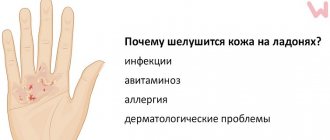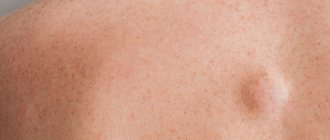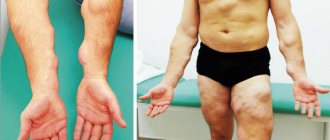In this article we will look at how you can get rid of such an unpleasant skin defect as a keratoma. Let's study what specialized drugs for this disease are sold in pharmacies. Let's analyze the most popular folk remedies and study the method of influencing these tumors. Let's make a list of measures that will help to avoid the appearance of keratoma in the future.
Before you begin treatment for any disease, you need to understand what it really is. In this article you will find a detailed description of such a disease as keratoma, and also learn about the reasons for its occurrence.
Keratoma is a benign neoplasm. It consists of dead skin cells. Cell mutation occurs and the process of skin regeneration in a particular area slows down. Dead cells do not peel off, but accumulate on the surface, creating a brown growth. Keratomas often peel off. Excessive use of tanning is often cited as the cause of its appearance; ultraviolet radiation provokes the growth of the epidermis. Most often, keratomas appear in people over 50 years of age.
What is a keratoma
Keratoma is a skin disease that is characterized by benign age-related changes in the epithelium.
Keratomas usually appear after 50 years. The disease manifests itself in the form of pigment spots on the skin of a coffee or grayish color. In appearance, the keratoma resembles a freckle, colored dark brown. Over time, the spots become keratinized, peel, and turn into dark brown or black plaques.
Keratomas are localized in places that are often exposed to direct sunlight: face, neck, hands. After growth, the neoplasm can fall off on its own, leaving no trace of its existence.
Sometimes keratomas grow quickly and transform into malignant formations, so it is important to visit a doctor even at the slightest sign of this disease. It is easier to cure keratoma in the early stages with a course of therapy.
Photo
Nuances of laser removal of keratomas
Laser removal of keratomas in St. Petersburg involves the use of a specialized installation that generates a directed beam. The efficiency of performing the necessary actions is ensured by a special attachment.
The removal device uses the properties of a light beam and a special mirror system. Thus, the beam is directed to the desired location, causing the cells to burn. At the same time, coagulation of the destroyed vessels occurs. Thus, the risk of open bleeding is completely eliminated.
Symptoms of keratoma
The formation of a keratoma occurs with the appearance on the surface of the skin of a small speck of a grayish or coffee shade. The spot is convex and protrudes slightly above the surface of the skin; the surface of the neoplasm sometimes peels off.
Over time, the keratome begins to increase in size, and a dense crust develops on the surface, which sometimes comes off. Periodically, bleeding occurs, which causes unpleasant pain. Keratoma can be either single or multiple.
How to fight the disease?
- when exposed to the sun for a long time, use sunscreen lotions and sprays;
- buy clothes made from natural fabrics;
- Do not rip off, scratch or remove formations yourself;
- do not mask the formation with foundation;
- Avoid contact with chemicals and poisonous plants.
To prevent keratoma, attention should be paid to immunity, hygiene, vital activity and diet.
During the course of the disease, it is recommended to consume more foods rich in vitamin P. Berries, grapes, plums, spinach, and cauliflower contain large amounts of vitamin P. An increased amount of vitamins and beneficial microelements is found in citrus fruits, parsley, legumes, buckwheat and green tea. If the growths have grown and begun to cause discomfort and pain, you should consult a dermatologist.
How to treat keratoma
Although the keratoma itself is a cosmetic defect, there is a possibility of malignant degeneration of this formation. And although the chance of this is small, it is better not to expose yourself to unnecessary risk.
Doctors have developed methods to remove keratomas from the human body. Do not hide the defect under a thick layer of foundation. This will only make the situation worse.
Since keratoma often becomes a sign of aging of the skin, methods that slow down aging should be used for treatment. Yellow foods are included in the diet. In addition, vitamin P prevents early skin aging.
It is necessary to remove the defect only if the tumor causes inconvenience or the risk of degeneration into a malignant tumor increases.
Service cost
Price information is provided in our price list. The full cost of the keratoma removal service depends on the method used, as well as the size and number of tumors.
We suggest you evaluate in the photo the results of treatment of skin formations of this type at the Podology Clinic. The use of modern technological methods, as well as the efforts of our highly qualified doctors, help to perform the operation quickly and without the risk of noticeable scars.
If you need to get rid of keratoma, contact the Podology Clinic. You can make an appointment by calling +7 (495) 640-68-10.
Treatment of keratoma
Methods of traditional elimination of the disease are used for 3-4 types of keratomas, the rest do not respond to this effect - they are removed.
Keratomas that tend to develop into cancerous tumors are treated with local administration of cytostatics. Application with the same drugs is also possible. Treatment is not carried out at home, the patient is treated in a hospital under the strict supervision of the attending physician. The growth is reduced with the help of colchamine ointment, which is used as a compress.
When eliminating the seborrheic type of keratoma, the injection into the lesion of the drug Solcoderm, containing a mixture of nitric, lactic and acetic acid, works. Follicular growths disappear after curettage of the hair follicle next to which they appear.
How to get rid of senile keratomas?
There are various modern methods of combating the disease: laser therapy, radiosurgery, surgery. These methods are used in advanced and severe stages of the disease. To prevent growths from turning into cancerous tumors, products purchased at the pharmacy are used. With this therapy, antibiotics and cytostatics are used, which are injected directly into the formation. Antiseborrheic medicine (Solcoderm) and antitumor ointment (Colhamin ointment) are widely used.
It is possible to remove keratoma at home not only with pharmaceutical ointments, but also with regular iodine. To do this, it is enough to apply iodine pointwise to the growths 2 times a day for 14 days. Low-budget and highly effective at the initial stage of the disease is the treatment of keratosis with folk remedies. The use of natural herbal ingredients will help reduce exanthema, cure keratosis irritation, relieve itching and normalize the general condition of a person.
It is recommended to consult a dermatologist before treating actinic keratoses with folk remedies.
For self-therapy of keratoma, you can use pharmaceutical preparations or make medicinal products manually.
Keratoma removal
If a keratoma appears, you should not use independent treatment. Such interference can negatively affect the patient's health. Injuries sometimes lead to transformation of the tumor into squamous cell carcinoma, so unprofessional treatment only increases the risk of such degeneration.
If a person has a keratoma, one should not delay treatment and remove the formation as early as possible, then there will be no marks left on the skin. The following removal methods are practiced:
- Laser removal is the most effective method. The procedure is carried out once, after which, as a rule, a keratosis does not form in the same place.
- Cauterization with nitrogen is an inexpensive way to remove keratoma. The procedure is painful, the treated tumor disappears after 5-7 days, healing takes a long time, and sometimes a scar remains.
- Radiosurgery is a common method used in cosmetology. During the operation, a special radio knife is used. This is a non-contact method of removal, after which, as a rule, tissue compaction and scars do not occur.
- Electrocoagulation, in which the keratoma is exposed to high-frequency current, causing strong heating and destruction of the formation.
- A surgical method in which removal is done using a medical scalpel. After removal of a keratoma, scars or cicatrices sometimes form, depending on the individual characteristics of the patient's skin.
Medications
A neoplasm such as a keratoma is not considered dangerous. Overgrown epidermal cells do not have a tendency to mutate into malignant tumors. However, before you start self-treatment, you need to be absolutely sure that it is a keratoma. A keratoma can be confused with a wart, mole, or even melanoma. In such cases, independent intervention is extremely dangerous! Keratomas that have affected the deep layers of the skin, multiple keratomas or large formations are best removed by a surgeon. You can deal with small keratomas on your own.
Pharmacies offer a huge list of medications. Let's consider what is available to get rid of keratoma.
“Papillek”
The drug consists of celandine extract, acetic and citric acids, polysaccharides, potassium and plant extracts. This is a bottle of liquid emulsion, equipped with an applicator for ease of application. In addition to keratomas, the product will help get rid of papillomas, calluses, corns, and warts.
For treatment, apply a thin layer of the drug to the keratoma, avoiding contact with healthy skin if possible, wait until the liquid dries and forms a film and do not wash off for 10 hours. If the keratoma is located on a bend or an open part of the body, for example, on the arm, it is better to cover the lesion with a plaster after application. In order to cure keratoma, 2 such treatments are enough. Keratomas on the face should be handled very carefully and avoid getting the drug in the eyes.
The instructions say that the recovery process takes up to 2 weeks. The new growth will darken and peel off. Based on the composition, we can conclude that the medicine works on the principle of chemical peeling - it simply burns and dissolves the layer of skin, in this case the keratinized epidermis. Therefore, it is prohibited for the composition to come into contact with healthy areas. If you decide to use this product, stock up on sea buckthorn oil; it is good for lubricating the skin around the lesion and after removing the formation.
The price is approximately 330 rubles.
“Verrukatsid”
This is a drug for external use in the form of a solution. The active ingredients here are phenol and metacresol. The medicine has a wide spectrum of action, copes well with warts and papillomas, and also destroys condylomas and calluses.
To cure keratoma with this remedy, it is necessary to spot-treat the growth with a liquid composition using the applicator, which is located on the bottle cap. You can also use a wooden spatula. After 4 minutes, the treatment should be repeated, and so on 3-4 times, depending on the size of the keratoma. In order not to damage the skin around the formation, you can lubricate it with zinc paste; after treatment with “Verrucacid”, the paste is removed with a dry swab.
Phenol (the main active ingredient of “Verrukacid”) is a highly dangerous substance, a poison. In this case, small doses of it act as an acid; in cosmetology it is used for deep peeling. In high concentrations, as in this drug, it chemically burns dead cells. Metacresol (an auxiliary active ingredient of the drug) is an antimicrobial and antifungal component that is designed to relieve secondary bacterial and fungal inflammation during treatment.
The price is approximately 225 rubles.
“Ferezol”
Almost an analogue of the previous product. Here, phenol and tricresol, an antimicrobial and anti-inflammatory agent, also act as active components.
There is no applicator here, so for application you need to stock up on a thin wooden stick. The liquid emulsion is applied pointwise to the keratoma 3-4 times, after allowing the previous layer to dry.
This medicine can burn healthy skin around the tumor or damage the epidermis under the keratoma. Chemical burns are treated traditionally - with healing and anti-burn ointments - “Panthenol”, “Levomekol”, etc.
The price is approximately 370 rubles.
Folk remedies for treating keratoma
Before starting treatment with folk remedies, consult your doctor. As a rule, home treatment for keratomas is carried out in the period before removal and is intended to relieve the discomfort associated with the appearance of keratomas, as well as to disinfect, moisturize and relieve inflammation. A complete cure with folk remedies is impossible.
Recipes for home treatment of keratoma:
- Therapeutic ointment from bay leaves is prepared as follows: take 6–7 bay leaves and one juniper leaf, chop and mix the ingredients. Add unsalted butter to the mixture). Oils are taken 10–12 times more than leaves. When the product is ready, add 15–20 drops of fir or lavender oil for every 100 grams. The ointment is carefully rubbed into problem areas of the skin.
- When injuring the keratoma, walnut oil is used. To do this, the nut pericarps are crushed into powder and mixed with baby cream (in a ratio of 1:5). The mixture is rubbed in carefully.
- Aloe leaves: before use, place in the freezer for 2-3 days. After thawing at room temperature, the leaves are applied to the affected area overnight. In the morning, wipe this area with salicylic alcohol. Course 3 weeks.
- You can also make a balm from walnuts: mix 1 part of unripe walnut fruits with 6 parts of vegetable oil, heated to 45°C. Next, the balm is infused for 24 hours in a thermos and filtered.
- In addition, fresh potatoes are used. To do this, the tubers are grated. Apply the paste onto the keratomas, and place a clean cotton cloth on top. After 30–40 minutes, rinse off the product with warm water.
- To treat senile keratoma, an ointment is prepared from bay leaves, which will delay the growth of tumors and reduce pain. To do this, take 6 powdered bay leaves, add a juniper leaf and mix thoroughly with butter (12 parts). Then add lavender or fir oil (15 drops per 100 grams of mixture).
- For growing keratomas that threaten to degenerate into a malignant tumor, before surgery they are treated with celandine leaves (mix powdered dry celandine leaves with rendered pork fat). To make this ointment last longer, add 10 drops of carbolic acid to it.
- To soften keratinized areas, keratomas can be gently wiped with warm vegetable oil (calcined in advance). Use sea buckthorn, fir or sunflower oil.
Treatment of keratosis: what methods exist
The most relevant type of treatment for keratomas offered by modern medicine is their removal. However, not every tumor of this type must be removed - most people who have this tumor live a long life and die for completely different reasons.
Thus, it is possible to cure a keratoma only by removing it, but such a need does not always exist. The only type of formation that must be removed in any case is the cutaneous horn.
Only those tumors that threaten to become malignant are subject to removal procedures. In order to identify them in time, it is recommended to visit a dermatologist once or twice a year for the purpose of a preventive examination and monitoring of neoplasms over time, and to remove only dangerous keratomas.
At the request of the patient, the doctor can also remove those keratomas that create a significant cosmetic effect, or are located in places where they are often injured due to friction or mechanical impact.
The most commonly used methods for getting rid of keratomas are:
- laser removal;
- electrocoagulation;
- cryodestruction;
- radio wave removal;
- destruction by acids;
- surgical intervention.
In each specific case, the doctor selects the most suitable method for the patient to get rid of the tumor. Firstly, the existing contraindications of each method and their presence in the affected person are taken into account. Secondly, removal methods may be suitable for one type of keratoma, but not for another. For example, if a malignant lesion is suspected, the doctor will prescribe the patient a radio wave, laser or surgical method, since other techniques are ineffective in this case. Laser and radio wave methods are less traumatic, and if the patient does not want the appearance of a noticeable scar after the procedure, one of them is chosen.
Keratomas that cause discomfort as a cosmetic defect can be removed with acids, cryodestruction or electrical cauterization.
Laser removal of keratomas: how it happens
This method is considered one of the most effective - during exposure to a directed light beam, a sharp increase in temperature occurs in the tumor cells, as a result of which they are completely destroyed. The percentage of relapses after laser removal is no more than 5-8% of all cases. Usually one session is enough to completely get rid of the tumor. Skin restoration after the procedure lasts 1-2 weeks, after which only a small, inconspicuous scar remains at the site of the keratoma.
Laser destruction is recommended for patients who have been diagnosed with the beginning of the process of malignant degeneration of keratoma.
The procedure can be carried out in an outpatient setting, and for this it is not at all necessary to place the patient in a hospital hospital. Today, the offices of dermatologists and oncologists in clinics, hospitals, cancer centers and private clinics are equipped with laser installations.
Electrocoagulation as a method of treating keratomas
Electrocoagulation is the process of cauterizing a tumor with an electric current. During the process, the keratoma is exposed to an electric current discharge. The doctor uses a precise and powerful electric knife to cut out the affected tissue.
As a result, tumor cells are burned. After the procedure, a crust remains at the site of formation, under which the wound heals. The crust disappears on its own after about 1.5-2 weeks, and in its place a pink or red patch of skin becomes visible. After about a month, the affected area acquires a normal flesh color. When treating small keratomas, this removal method leaves virtually no traces.
When performing operations on the face and hands, that is, in places where the formation of significant cosmetic defects is unacceptable, the electrocoagulation technique is not used due to the risk of extensive scars.
Cryodestruction: treatment of formations with liquid nitrogen
In the process, the doctor uses a special can with a spray and a nozzle that jets liquid nitrogen onto the treated area at a certain temperature. The procedure takes place mainly without the use of anesthesia, and the patient feels cold and tingling at the treatment site. The formation tissues are destroyed due to exposure to very low temperatures, and the keratoma dies. After this method of treatment, a crust also remains, which after about a month and a half is replaced by skin of normal color.
The disadvantages of the method include the inability of the doctor to control the depth of freezing, as a result of which a wound that is too painful can form, which after healing will leave a noticeable large scar. In addition, cryodestruction has a high probability of relapse, since it is difficult for the doctor to control whether he managed to freeze all the affected cells.
However, to remove small tumor foci that are localized on the torso or limbs, it is quite advisable to use the cryodestruction method.
What is the radio wave method
In this case, removal of the keratoma occurs through the use of a radioknife. The instrument cuts out the affected area from the skin, acting like a scalpel during surgery. In this case, smaller incisions are formed on the skin, which practically do not bleed. After the procedure, there are no noticeable scars left, and the procedure itself is almost painless.
The radio wave knife, in addition to destroying pathologically altered tissues, simultaneously coagulates damaged blood vessels and affects nearby tissues. Considering that affected cancer cells tend to spread into the plane of adjacent tissues, removal of basal cell carcinoma using the radio wave method eliminates the possibility of cancer recurrence.
Treatment of keratoma with acids and special substances
This method eliminates surgical intervention in the skin - the effect on the tumor is produced by aggressive components: acids and cytostatics. For these purposes, creams, ointments, lotions and emulsions are used externally.
Most often, the active ingredients in these drugs are trichloroacetic or glycolic acid, Podophyllin or 5-fluorouracil. Treatment of the affected area should be carried out by a doctor, since only a doctor can correctly calculate the dosage in order to prevent the occurrence of a chemical burn.
The application of the drugs lasts for some time, and gradually an ulcer forms at the site of the keratoma, which must be lubricated with special medications to speed up healing.
Surgical removal of keratomas
This method is carried out as an operation, during which the doctor uses a scalpel to cut out the tumor itself and a small area of skin around it, and then stitches the edges of the wound. Surgical removal by skin excision is certainly effective, but the wound after it takes much longer to heal than, for example, after a radio wave procedure. In addition, a postoperative scar remains at the site of the keratoma.
A surgical intervention of this nature is usually performed using local anesthesia, but in some cases, if there are no contraindications, the doctor may offer the patient general anesthesia, for example, if the area affected by the group of keratomas is very large.
Causes of keratoma
The main reason for the appearance of keratoma is prolonged exposure to direct sunlight. In addition, in old age, processes in the upper layer of the epidermis are disrupted, resulting in pronounced thickening of the skin and the appearance of pigmentation.
Additional causes:
- endocrine diseases;
- imbalance of metabolic processes in the body;
- mechanical damage to the skin: cuts and scars;
- heredity: the disease is transmitted through the male line;
- malnutrition: lack of vitamins A, C, B;
- chemical skin burns;
- decreased immunity.
How to use celandine?
Celandine juice is a good effective remedy to remove age-related keratomas. Careful and correct use of products with celandine heals ulcers and wounds on the body, the skin is cleansed of dry crusts. The method of using this plant is simple and accessible:
- put fresh celandine in a bowl and squeeze out the juice;
- filter through a sieve;
- add a couple of drops of olive oil;
- treat the skin at the affected area every day (30 days).
You can mix baby nourishing cream with celandine juice. You need to rub the resulting product 3 times a day.
Classification of keratoma
Keratomas are classified according to external manifestations, sensations or growth patterns.
Senile (cyanocystic) keratoma
This is a neoplasm on the human body, characterized by yellowish or brownish spots. Over time, they begin to peel off and gradually fall off. Dimensions do not exceed 2 cm. Darken or lighten with magnification. They appear more often on the face and neck. When damaged, they sometimes become inflamed and painful.
Seborrheic keratoma
This species is characterized by slow growth. At first, a light yellow spot appears. Then it becomes denser and becomes covered with scabs, which are easily separated. Over time it acquires a dark shade, often brown. When damaged, it bleeds and hurts. They often appear in groups.
Cutaneous horn
Another type of keratoma, which is the appearance of gray and brown spots that become horny over time. They look like a bump on the body, with an uneven surface, characterized by peeling. They develop as single or multiple neoplasms. Localization:
- face;
- head;
- genitals.
Other areas of the body are rarely affected.
Follicular keratomas
They form in the form of a node of pink shades, the diameter is no more than 1 cm. They are characterized by a rough surface that rises slightly on the skin. They rarely appear on the body and are localized on the cheeks and head.
Solar keratomas
At first, flaky plaques appear, which harden over time. They are most often localized on the face and back. Such formation is dangerous, because it is a harbinger of precancerous diseases. They can disappear on their own.
Angiokeratomas
This type of keratoma is rare and is characterized by specific blue or red nodes, no larger than 1 cm in size. Such neoplasms occur in newly born children. Localization of angiokeratoma:
- stomach;
- back;
- limbs;
- genitals.
What is the essence of the laser method for treating skin diseases?
The appearance of the laser as a physical phenomenon became possible after Albert Einstein developed the theory of interaction between matter and radiation at the beginning of the 20th century. It traced ideas for the possible creation of quantum radiation amplifiers and generators of electromagnetic waves.
The first ruby laser device was designed by the American scientist Theodore Maiman in 1960. The laser wavelength was 0.69 μm. At the same time, for the first time, the properties of laser were used to destroy human hair follicles. This event became the starting point in the history of laser surgery, medicine, and cosmetology.
Laser removal of keratomas refers to both medical and cosmetic procedures. Not only hospitals and private medical institutions, but also the offices of cosmetologists and dermatologists are equipped with special devices with an attachment that generates a directed laser beam.
The medical device used in the process, using the properties of light rays and a special system of mirrors, generates a laser beam. By directing it to the affected area, the doctor ensures that the cells of the neoplasm burn from its top to the deepest layers. At the same time, coagulation of the blood vessels damaged in the process occurs, which eliminates the risk of bleeding.
After treating the tumor in this way, a barely noticeable scar remains in its place. The duration of the wound healing period is rarely more than 3-4 weeks. There is virtually no risk of wound infection during the procedure.
In the laser surgery industry, lasers with high radiation power are used, due to which they can cause significant heating of biological tissue, which contributes to its evaporation or cutting. Such an intervention, although considered surgical, is minimally invasive.
Thanks to modern laser devices and systems, during the operation it is possible to ensure:
- dry work area;
- effective contactless and contact vaporization and destruction of biological tissue;
- minor damage to surrounding tissue;
- stopping lymphatic and blood vessels;
- effective hemostasis;
- high sterility of the process;
- the possibility of combining the procedure with laparoscopic and endoscopic measures.











